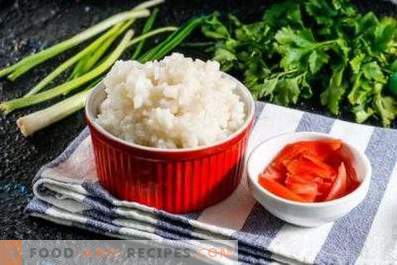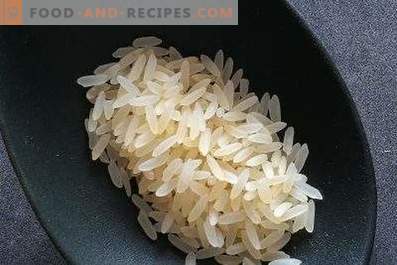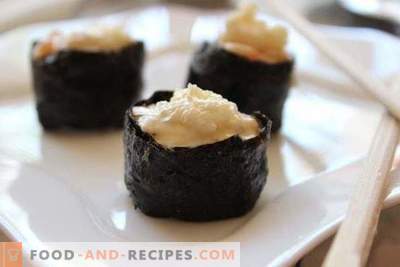
Delicious, healthy, healthy, exquisitely beautiful Japanese cuisine presented the world with rolls and sushi. Many still confuse these dishes, and for good reason.
They are actually very similar. Only the way of serving and the amount of ingredients used differ.
Rolls are a specially rolled rice-fish pieces, wrapped with a sheet of pressed nori seaweed. In fact, this is just a type of sushi - rice and seafood dishes with vinegar dressing.
In any case, the basis of rolls and sushi is rice. Its taste and texture are different from the product used in Russian or, for example, Uzbek cuisine. Combines rice with any seafood: fish, algae, shrimp, caviar. In the rolls often put fresh cucumbers, sesame, fruit.
Experiments can be carried out any. But the main component of rolls and sushi is still rice. To get real pleasure from the meal, it is important to know how to cook rice for rolls and sushi. On its basis, you can complement traditional recipes to your liking, experiment with pouring, each time getting a new taste.
How to cook rice for rolls and sushi - general principles of cooking
Prepare Japanese dishes at home every woman can afford. Today, the kitchen of the island state is so popular that in any supermarket there is a rack with all the necessary products: Japanese rice, pressed noria algae, rice and soy vinegar, pickled ginger.
Before you cook rice for sushi, you need to decide on the type of grain. Incorrectly boiled rice for rolls or sushi falls apart as soon as a piece is in a bowl with soy sauce. This happens for two reasons:
1. The dish is made from inappropriate rice;
2. rice itself is cooked wrong.
As for the “right” rice, it is not necessary to buy a product labeled “Japanese” or “for sushi”. In fact, we are talking about ordinary round grain rice, and you should not overpay for a “hint”.
Of course, you can buy real Japanese rice. But our Krasnodar quite fit for overseas dishes. And all because it has the necessary qualities: it is well boiled soft and has high stickiness. It is important that the boiled rice grains are well glued to each other. The story of crumbly rice is not for sushi. Therefore, it is impossible to use long grain rice, including steamed rice. Not suitable and useful brown, brown, black (wild) product. For rolls and sushi, extremely white sticky grains are needed. Otherwise, the question of how to cook rice for rolls becomes meaningless.
They need to be properly prepared: rinse in several waters (at least seven times). Water must be very cold and clean. Merged with rice grain ready for cooking, it should remain absolutely transparent.
The principles for making rice cereal are as follows:
• boil it properly until fully cooked;
• separately prepare the filling (rice vinegar, salt and sugar are required);
• combine hot rice and vinegar pouring.
In principle, you can simply cook the rice grain the way you used to do it, and then pour it over the dressing and mix thoroughly. Or pour the grain into the slow cooker and entrust the process to it. But to maximize the effect of the restaurant is to learn how to cook rice for rolls and sushi. There are several ways, and mastering them is not at all difficult.
How to cook rice for rolls in the traditional way
Perfect rice is soft, tender, but not digested grains. They easily take the desired shape, so rolls and sushi are tasty, keep their shape perfectly and are not much different from restaurant ones. How to cook rice for sushi in the traditional way?
Ingredients:
• a glass of round grain (or special Japanese) rice grain;
• one and a half glasses of water;
• half table spoon of granulated sugar;
• half a spoonful of salt;
• 50 ml of real rice vinegar.
Preparation:
Prepared grains of white rice put in a thick-walled pan.
Pour rice in a measured portion of water. One to one and a half ratio - the ideal ratio of grain and water. Do not add salt, do not add any spices.
Turn on high heat and wait for the boiling water. The lid must be open.
As soon as the first signs of boiling appear, reduce the fire to minimum and cover the saucepan with the lid as tightly as possible.
How to cook rice for sushi? Not more than ten to fifteen minutes. It is important that the moisture completely evaporated, but it is impossible to overstate rice on a fire. Overcooked rice grains will spoil a delicious dish. While the rice is being cooked, prepare the dressing. To do this, pour vinegar into a saucepan or a small saucepan (it is rice rice vinegar that is needed, and not some other vinegar).
Pour sugar and salt into it.
Put the dishes on a small fire and wait until the grains are completely dissolved. It is important to stir the sauce so that the sugar will dissolve faster and not burn.
When the grains of sugar and salt disappear, pouring is ready.
Remove the boiled rice from the heat and leave under the lid for ten minutes.
Transfer the rice grains into a large wide bowl, pour over the hot vinegar dressing.
Gently mix the rice with vinegar using a wooden spatula.
When the rice has cooled to a warm state, proceed to the formation of rolls or sushi.
How to cook rice for sushi in a “hot” way
Delicate, sticky rice can be cooked differently. In this case, rice is poured into boiling water, and its amount increases. How to cook rice for hot rolls?
Ingredients:
• a cup of white round rice;
• two glasses of clean water;
• two tablespoons of vinegar;
• a teaspoon of sugar;
• a teaspoon of salt.
Preparation:
Boil the water in a suitable volume pot (the amount of rice will increase about three times).
Wash rice to clear water.
Pour the grain into the boiling water, reduce the fire to a minimum.
Cover the pan tightly, cook rice for 15-20 minutes until the water is completely absorbed into the grain.
Prepare the dressing as described in the first recipe.
Remove the cooked rice from the heat, sprinkle by pouring and mix with wooden sticks or a wooden spoon.
How to Cook Rice for Sushi with Nori Algae
To give the rice a special flavor, you can use a sheet of nori. A small piece of pressed sheet is required. Before cooking rice for sushi, you just need to put it in water. It is important to remove it from the pan after boiling water. Proportions are indicated for a large number of rolls.
Ingredients:
• four hundred grams of rice;
• half a liter of water;
• a small piece of pressed noria seaweed;
• 50 ml of rice vinegar;
• 30 grams of sugar;
• 10 g of salt.
Preparation:
Pour cold water over rice.
Throw a piece of nori into the water, close the pan with a lid. Turn on the maximum heat and wait for the boiling water.
Remove algae, reduce heat to minimum.
Boil rice for exactly twelve minutes.
Turn off the heat and leave the rice under the lid for another fifteen minutes.
Prepare vinegar pouring.
Combine it with rice, mix.
How to cook rice for sushi: tips and secrets
- The maximum cooking time for rice after boiling water is twenty minutes. If possible, do not remove the cover. For the first time, of course, it is impossible to do without checking the grain for boiling water. Rice can be cooked after 15 or 20 minutes. Much depends on the characteristics of the plate and rice varieties. But over time, experience will come, which will ensure that the grain is completely dormant under the lid.
- Under no circumstances should you touch the rice with a spoon, mix and disturb it. We remember one of the commandments: complete peace!
- Ready rice needs to be cooked right away. Leave it on another day, you can not store in the refrigerator. In just a few hours, the boiled grains will rapidly lose moisture. Rice will be hard and completely unsuitable for making rolls and sushi.
- Refueling and rice should be mixed hot. Fill should not boil: she needs to give a few minutes to cool. The number of refueling should not be too large. The challenge is to give the rice a light aroma and pungent vinegar taste.
- You can buy in the store a ready-made sushi-rice dressing. It replaces homemade fill of rice vinegar and sugar with salt.
- Cooking rolls and sushi should be from cooled completely prepared rice. The Japanese use a special fan to fan and cool the boiled rice grains. If you want to feel yourself in the atmosphere of old Japan, you can work as a fan. However, this is not necessary.























